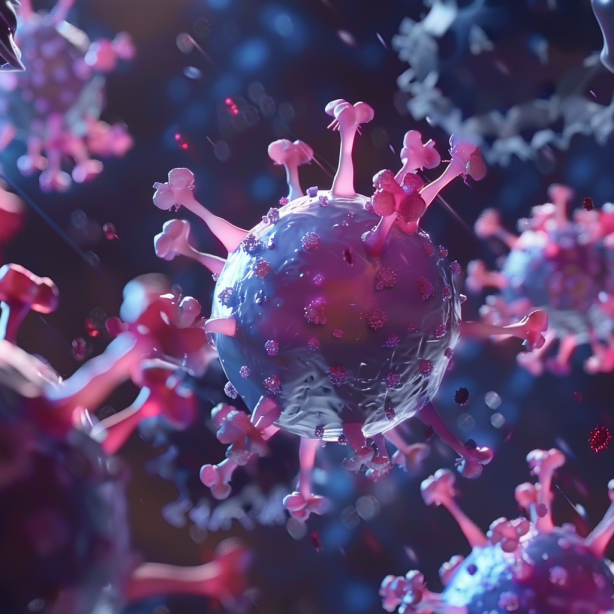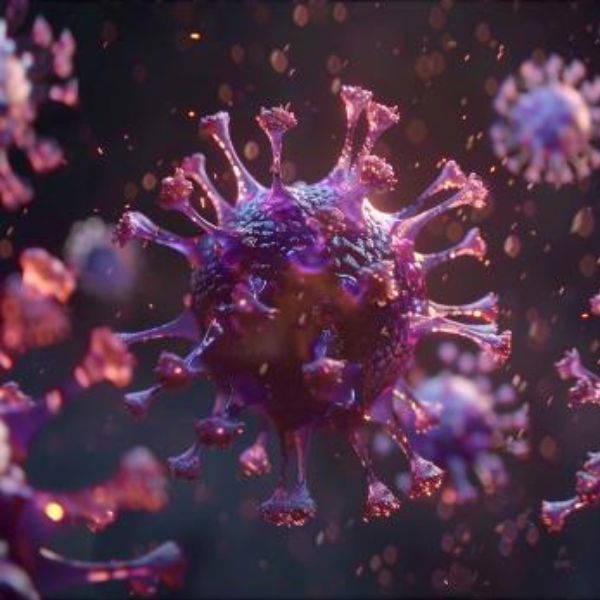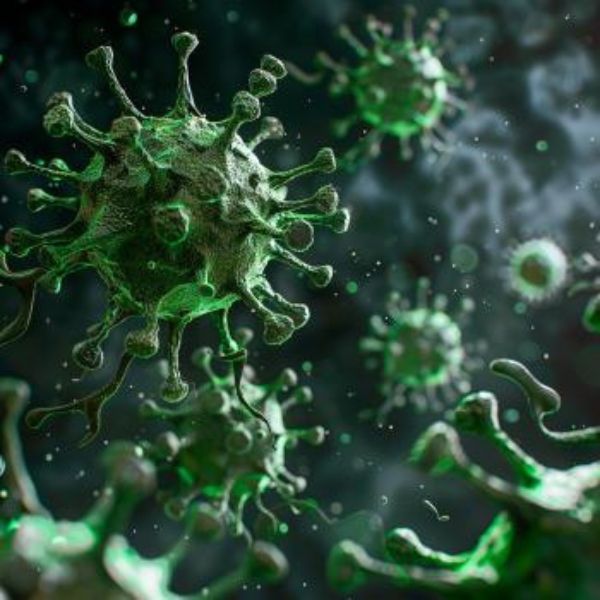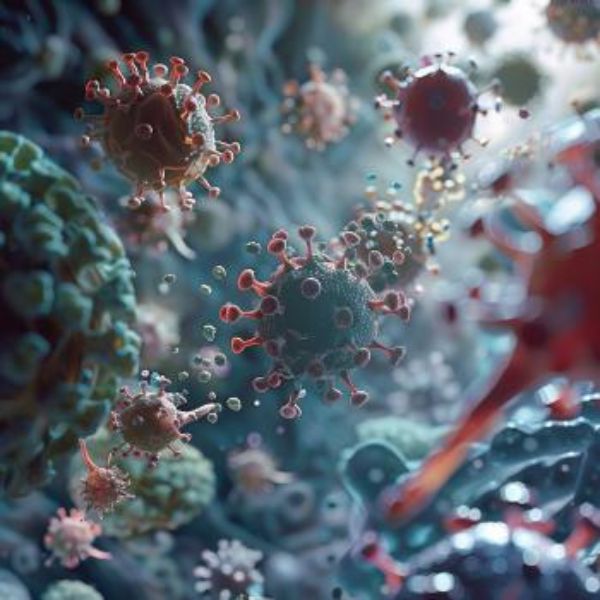
Introduction
How do viruses reproduce? These microscopic agents can only multiply within the living cells of other organisms, lacking the necessary cellular structures for independent reproduction. They must invade host cells and utilize the host’s machinery to propagate, often causing harm to the host in the process. Understanding this fundamental aspect of viruses is crucial for both medical professionals and the general public to grasp the mechanisms behind viral diseases and the importance of preventive health measures.
How do viruses reproduce and why is this knowledge important? Understanding the reproduction process of viruses is essential for developing effective medical strategies to combat viral infections. It enables scientists and healthcare providers to predict viral behavior, evolution, and treatment response. Additionally, educating the public about viral reproduction demystifies infection spread and reinforces the need for vaccinations and other preventive health practices, empowering individuals to make informed health decisions.
If you are looking to create a video about how viruses reproduce, please contact us at Austin Visuals. We can help visualize these complex biological processes in a way that is easy to understand and visually engaging. Email us at [email protected] or call +1-512-591-8024. Visit our websites at Austin Visuals and Medical 3D Animation Company for more information on our animation services.
Our Clients include:
What Are Viruses?
The Nature and Classification of Viruses
Viruses are minuscule infectious agents that exist at the edge of life. They lack the capacity to carry out life processes independently and require a host cell to replicate. Structurally, viruses consist of genetic material, either DNA or RNA, encased within a protein coat called a capsid; some viruses also have an additional lipid envelope. They are classified based on their genetic material, shape, replication method, and the type of host they infect—ranging from plants and animals to bacteria and archaea. This classification helps scientists understand viral behavior and develop targeted treatments or vaccines.
Viruses vs. Bacteria: Key Differences
Understanding the differences between viruses and bacteria is crucial for diagnosing infections correctly and prescribing effective treatments. Unlike viruses, bacteria are living organisms that can survive and reproduce outside of a host. They are generally larger than viruses and have a more complex structure with a cell wall and the ability to perform metabolism. Bacterial infections can often be treated with antibiotics, whereas viral infections cannot and may require antiviral drugs or vaccines to manage. The treatment distinction stems from their differing structures and life cycles, highlighting why distinguishing between these two types of pathogens is essential in medical science.

How Do Viruses Reproduce and Impact Our Health?
How Do Viruses Reproduce?
Entry Into the Host Cell
How do viruses reproduce? Their replication process begins with entry into a host cell. Viruses cannot penetrate cells unaided; they must attach to specific receptor sites on the cell’s surface. Each virus has a preference for certain types of cells, known as host specificity, which is determined by the virus’s structure and the host cell’s receptors. Once a virus finds a compatible cell, it uses one of several mechanisms to gain entry—some directly fuse with the cell’s membrane, while others are engulfed by the cell in a process called endocytosis.
Hijacking the Cellular Machinery
After entering the host cell, the virus moves to the next phase of its life cycle: hijacking the cell’s machinery. This step is critical for viral replication. The virus releases its genetic material into the cell’s nucleus, where it integrates with the host’s DNA or exists independently in the cytoplasm, depending on the type of virus. It then coerces the host cell to begin producing viral proteins and nucleic acids instead of the cell’s normal products. These components are crucial for assembling new virus particles, which can then infect additional cells. This takeover disrupts normal cell function, often leading to cellular damage or death, and can result in disease symptoms in the host organism.
Stages of Viral Reproduction
-
Attachment and Penetration
The first stage in the viral life cycle is attachment and penetration. Viruses begin by attaching themselves to a host cell using specific molecules on their surface, which bind to receptor molecules on the cell membrane. This specificity determines which cells a virus can infect. Once attached, the virus penetrates the host cell’s membrane through various mechanisms, such as fusion or endocytosis, effectively gaining entry into the cell to deposit its genetic material.
-
Uncoating of the Genome
Following entry into the host cell, the virus undergoes uncoating. This process involves the removal of the virus’s capsid, the protein shell encasing its genetic material. Uncoating is crucial as it exposes the viral genome to the cellular environment, allowing it to proceed with the next steps of replication. This stage is typically facilitated by cellular enzymes that dissolve the capsid, releasing the viral nucleic acids.
-
Use of Host’s Cellular Machinery
With the viral genome uncoated, the virus can now exploit the host’s cellular machinery. The viral nucleic acid hijacks the cell’s ribosomes to synthesize viral proteins and replicates its genome using the host’s enzymatic machinery. This redirection of the host’s resources is pivotal, as it shifts the cell’s efforts from its normal functions to the production of viral components.
-
Assembly of New Virus Particles
Once the viral components are synthesized, the next phase is the assembly of these components into new virus particles. This stage involves the combination of newly made viral proteins with copies of the viral genome to form complete virions, the fully formed virus particles ready to infect other cells.
-
Release of New Viruses
The final stage in the viral reproduction process is the release of new viruses from the host cell. This can occur through lysis, where the cell bursts and releases the virus particles, or through a process known as budding, where viruses leave the cell one at a time by pushing through the cell membrane. This release process often results in the death of the host cell and the spread of the virus to nearby cells, continuing the cycle of infection.
Understanding these stages helps in the development of antiviral drugs and vaccines, targeting specific parts of the replication process to effectively stop the spread of the virus.
Types of Viral Replication Cycles
1. The Lytic Cycle
The lytic cycle is one of the primary methods of viral replication, characterized by the rapid takeover of the host cell’s machinery to produce new viruses, which ultimately leads to the cell’s destruction. In this cycle, after entering the host cell, the virus immediately hijacks the cellular processes to begin producing viral proteins and DNA. Once the assembly of new virions is complete, the host cell lyses (bursts), releasing the newly formed viruses into the environment, ready to infect adjacent cells. This cycle is typical of many bacteriophages and some animal viruses, which are known for their aggressive and damaging effects on the host.
2. The Lysogenic Cycle
In contrast to the lytic cycle, the lysogenic cycle involves the incorporation of the viral genome into the host cell’s DNA, where it can replicate silently along with the cell’s genetic material without causing immediate harm. This viral DNA inserted into the host’s genome is called a prophage when dealing with bacteriophages, or a provirus in the context of animal viruses. During each cell division, the prophage or provirus is also replicated, passing to the daughter cells. Under certain triggers, such as stress or specific environmental factors, the viral genome may exit the host DNA and enter the lytic cycle, leading to active viral production and potential cell destruction. This cycle allows the virus to persist in the host without detection by the immune system, making it a sophisticated method of viral reproduction.
Both cycles represent strategic survival mechanisms for viruses, adapting to environmental conditions and host defenses, thus challenging medical science to find effective treatments that can disrupt these cycles and prevent the spread of viral infections.
Factors Influencing Viral Reproduction
Host Cell Type and Viral Tropism
Viral tropism refers to the specificity of a virus for a particular host cell type, determined by the virus’s ability to bind to specific receptors on the cell’s surface. This specificity is crucial because a virus can only replicate and proliferate if it successfully invades a compatible host cell. For example, the influenza virus primarily targets respiratory tract cells, while HIV infects specific immune cells. Understanding and studying viral tropism helps researchers develop targeted therapies that can block viruses from attaching to and entering their preferred cells, thus hindering their ability to replicate.
Environmental Conditions and Viral Reproduction Rates
The rate of viral reproduction can also be significantly influenced by environmental conditions. Factors such as temperature, humidity, and pH can affect how well a virus survives outside a host and its ability to replicate within a host. For instance, colder temperatures and lower humidity levels can enhance the stability and airborne lifespan of respiratory viruses like the flu, leading to seasonal outbreaks. Similarly, the pH of the surrounding environment can affect the infectivity of viruses; some are better suited to acidic conditions, while others thrive in neutral or basic environments. Understanding these environmental impacts is vital for public health strategies, as it aids in predicting and controlling viral spread based on seasonal and geographical patterns.
These factors collectively determine the effectiveness of viral propagation and are essential considerations in the fields of virology and infectious disease control, guiding prevention and treatment strategies.
Visualizing Viral Reproduction Through Medical Animation
The Role of Medical Animations in Understanding Viruses
Medical animations play a pivotal role in enhancing our understanding of viruses and their complex life cycles. By visually depicting how viruses invade host cells, replicate, and spread, animations make these microscopic processes accessible and comprehensible to a wide audience, including students, healthcare professionals, and the general public. Such animations are particularly invaluable in explaining the mechanisms behind viral infections and the actions of antiviral drugs. They serve not only as educational tools but also as a means to foster a greater understanding of public health measures, helping viewers visualize abstract concepts that are difficult to grasp through text alone.
How Austin Visuals Crafts Detailed Animations for Medical Education
At Austin Visuals, we specialize in creating high-quality, detailed animations that bring the intricate world of viral reproduction to life. Our process begins with a thorough consultation with virologists and medical experts to ensure accuracy in every frame. Using cutting-edge technology and software, our skilled animators craft precise and engaging animations that depict the dynamic interactions between viruses and host cells. We focus on clarity and educational value, ensuring that each animation is not only scientifically accurate but also easy to understand. Our animations are tailored to suit the educational goals of our clients, whether they’re for academic use, professional training, or public health awareness. This commitment to excellence and detail makes Austin Visuals a leader in the field of medical animation.
Implications of Viral Reproduction in Medical Research
Vaccine Development and Viral Reproduction
Understanding the nuances of viral reproduction is a cornerstone in vaccine development. Each stage of a virus’s life cycle offers potential targets for intervention. Vaccines work by priming the immune system to recognize and combat viruses before they can establish an infection. By studying how viruses attach to host cells, enter them, and replicate, researchers can identify crucial viral proteins to target. These proteins often become the antigens included in vaccines, which, once recognized by the immune system, can trigger protective immunity. This preemptive strategy is crucial for managing and preventing outbreaks of viral diseases, highlighting the direct application of viral reproduction knowledge in creating effective vaccines.
Antiviral Drugs and Targeting Reproductive Cycles
Similarly, antiviral drugs are designed to disrupt various stages of the viral reproductive cycle, thereby halting the spread of the virus within the host. For example, some antivirals prevent viruses from binding to host cells, while others inhibit viral replication by targeting the enzymes that synthesize viral DNA or RNA. Understanding the specific replication mechanisms of different viruses allows for the development of targeted therapies that are more effective and have fewer side effects. This strategic interference with viral reproduction is essential for treating viral infections, particularly for viruses that are fast-evolving and capable of eluding other therapeutic strategies.
The detailed study of how viruses reproduce facilitates significant advances in medical research, contributing to the development of vaccines and antivirals that save lives and prevent the spread of infectious diseases. Each discovery in this field enhances our capacity to fight viral pathogens, underscoring the importance of viral reproduction knowledge in ongoing medical innovation.
Preventative Measures and Public Health
Vaccination and Its Role in Controlling Viruses
Vaccination remains one of the most effective public health strategies for controlling viral infections. By introducing a safe component of the virus, such as a protein or a weakened form of the virus, vaccinations stimulate the immune system to recognize and combat the pathogen without causing the disease. This preemptive immune response ensures that if individuals are exposed to the virus in the future, their immune systems are prepared to respond swiftly and effectively, reducing the severity of the illness or preventing it altogether. Widespread vaccination can lead to herd immunity, where a large part of the community becomes immune, limiting the spread of the virus and protecting those who are not immune.
Public Health Strategies to Prevent Viral Spread
In addition to vaccination, various public health strategies are crucial in preventing the spread of viruses. These measures include promoting regular handwashing, maintaining hygiene in public spaces, and implementing quarantines or travel restrictions during outbreaks. Public education campaigns are also vital, informing citizens about the ways viruses are transmitted and the steps they can take to reduce their risk of infection. During pandemics, timely communication and coordinated responses are essential to manage and mitigate the impact of viral diseases on the community. These strategies, combined with ongoing research and surveillance, form the backbone of public health efforts to combat viral infections effectively.
Together, these approaches highlight the importance of proactive public health policies and individual actions in controlling viral outbreaks, ensuring communities are better protected against both seasonal viruses and pandemic threats.
The Future of Viral Research and Animation
Emerging Trends in Virology and Medical Illustration
The field of virology is continually evolving, with new technologies enhancing our understanding of viral behavior and infection processes. One significant trend is the integration of high-throughput genomic sequencing, which allows researchers to quickly identify viruses and understand their mutation patterns. Coupled with advances in bioinformatics, these tools are revolutionizing the way we track and respond to viral outbreaks. Concurrently, medical illustration, particularly in the form of digital and 3D animation, is playing an increasingly vital role. These illustrations and animations are not just supplementary tools but foundational in explaining complex viral mechanisms in an accessible manner, enhancing both academic and public understanding.
How Advanced Animations Could Change Medical Training and Public Awareness
Advanced animations have the potential to transform medical training and public health education by providing clear, visual representations of intricate scientific concepts. For medical students, animations can simulate viral infection processes in ways that are impossible in a traditional classroom setting, offering interactive experiences that foster deeper understanding and retention of knowledge. For the public, animations can be instrumental during health crises, such as pandemics, to effectively communicate preventive measures and the science behind viral transmissions. By making information visually engaging and easier to comprehend, animations have the power to enhance public awareness and encourage more informed health decisions, ultimately leading to better health outcomes and more robust public health responses.
These advancements in animation technology and their application in virology highlight a promising future where complex scientific data becomes more accessible, educational, and actionable for diverse audiences.

How Do Viruses Reproduce and Impact Our Health







